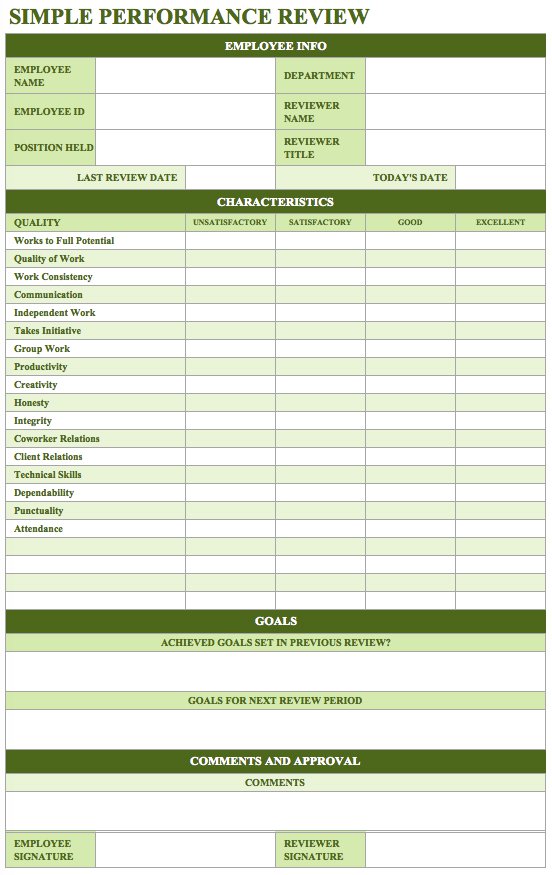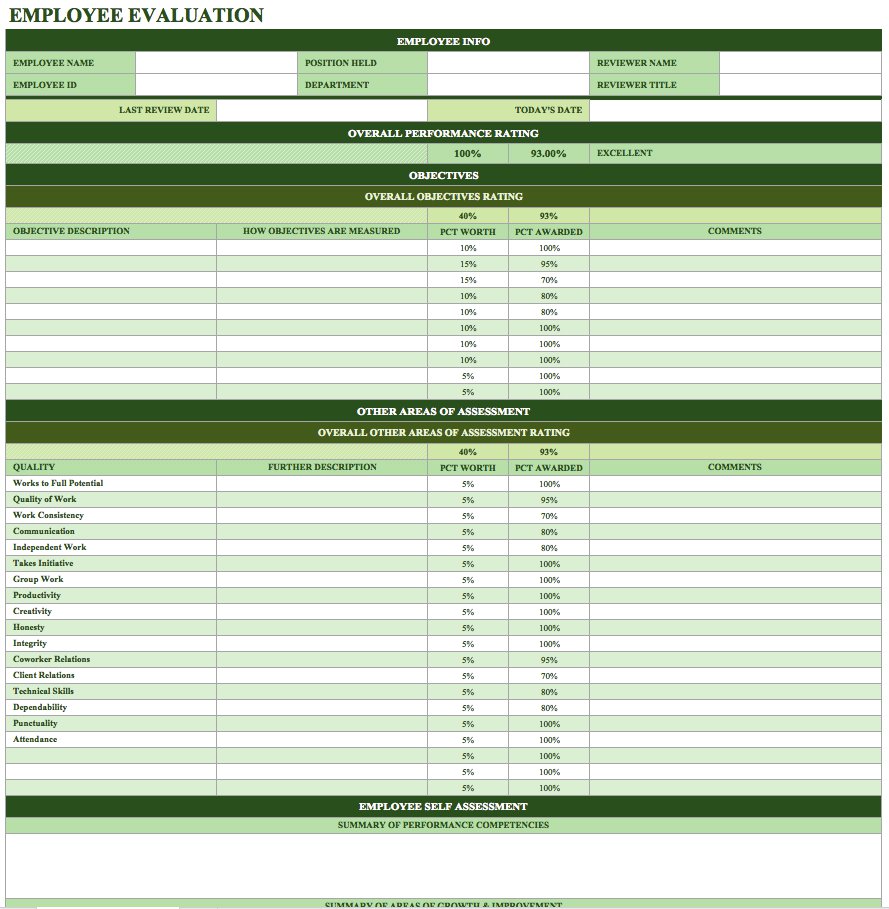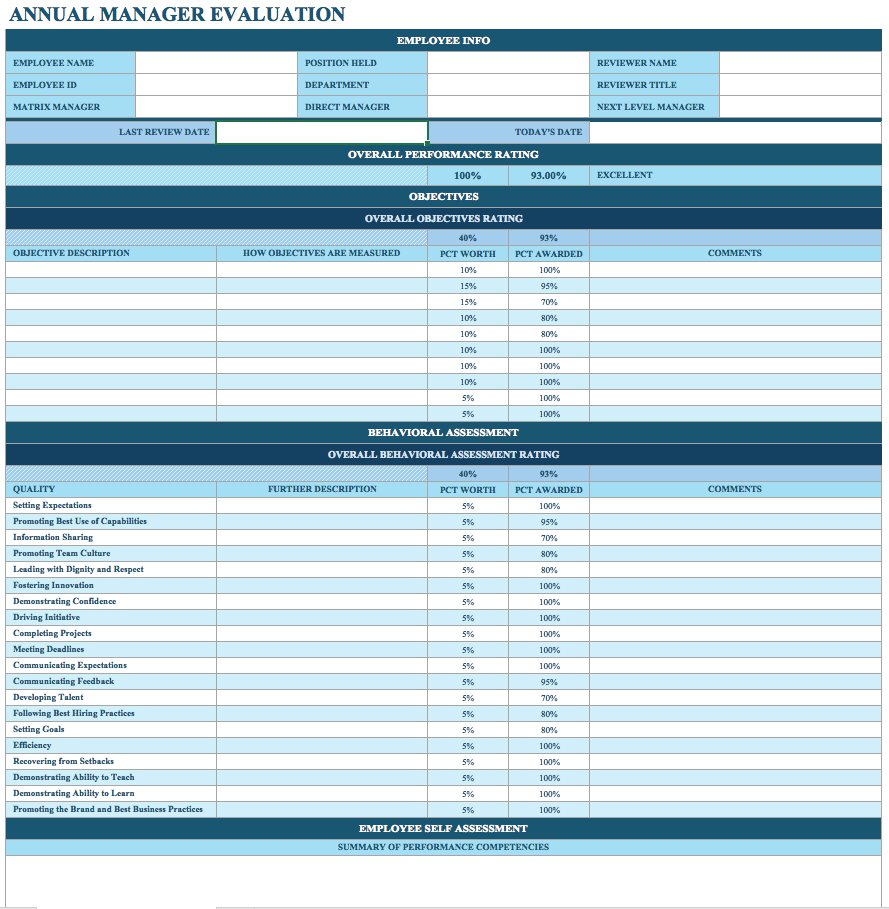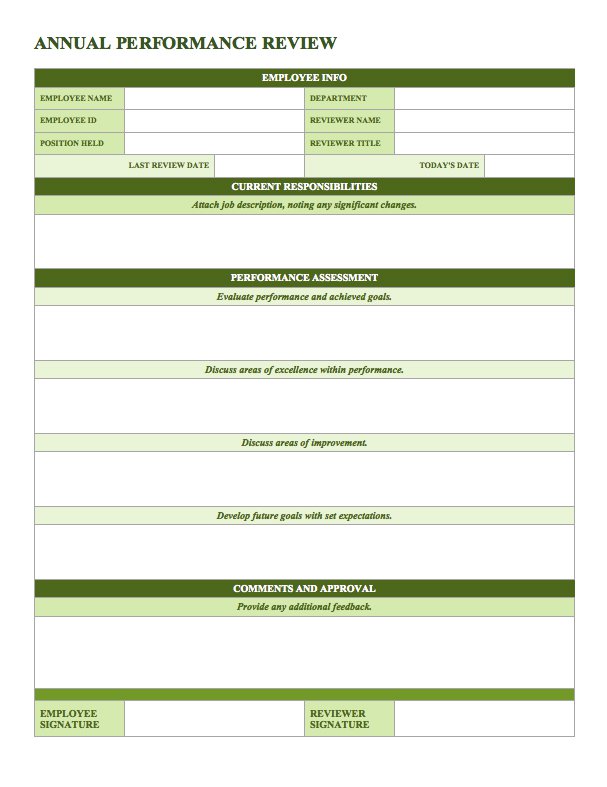The success of the performance management process heavily relies on selecting a good performance appraisal form. Finding one that suits the nature of your business and performance management needs is essential.

Performance appraisal forms should be able to collect all the necessary information needed to manage performance easily.
What is Performance Appraisal?

Performance appraisal forms review an employee’s performance, solely dependent on his contribution to the company. A systematic evaluation evaluates an employee’s skills, achievements, growth, and failures.
It provides feedback to employees about their performance level and ways to improve it as needed by the company.
A recent report suggested that 72% of employees feel that their performance would improve with healthy feedback, while 25% would leave the organization due to a lack of appreciation!
This tells you that employees’ appraisal management needs to be addressed effectively to have a healthy working environment.
How to Conduct An Effective Performance Appraisal?
Companies can conduct better performance reviews from the steps mentioned below to benefit their employees.

-
Be Prepared
An effective performance appraisal form helps the employer and the employees encourage a smooth open conversation during the meeting for the appraisal. For this, the employer should identify the employee’s on-the-job requirements.
Once the organization knows the employee’s needs, it must emphasize specific performance to improve the value proposition. The employer must then rate an employee’s performance with predetermined expectations to get a clearer picture.
-
Circulate The Agenda
A performance appraisal template will help confirm the matter of the discussion. After the company has collated its agenda for the meeting, it must send it to its employees to add any additional points they would like to discuss during the appraisal meeting.
By sharing the plan with the employees, the company can get an edge in preparing for the discussion.
-
Provide Detailed Performance Review
Companies must focus on providing a well-drafted performance review to their employees. The discussion will help the employees understand the worth of performance appraisal and learn something from the meeting.
While drafting the performance reviews, managers must put themselves in the employee’s shoes and imagine what an excellent performance review must look like. While conducting a performance review, managers must turn off all distractions to maintain the meeting’s essence.
-
Set A Professional And Friendly Tone
Since organizations already know the nature of their employees’ work, they must focus on delivering the feedback in a friendly yet professional way that communicates their message well without hurting employee sentiment.
Companies can give a positive thanksgiving note to their employees after the meeting ends. This will make them feel good and confident about their job even if their performance is not up to par.
-
Applaud Successes And Discuss Challenges
A performance review should not be a monologue by employers. They should know that the employees have an equal chance to put their views upfront during the meeting. By doing so, employers can observe the employee’s thoughts and ideas they bring to the table.
Employers must also remember that discussing only failures and challenges with the employees will do more harm than good. So, instead of stressing about the hurdles, the organization is facing. Instead, employers must focus on boosting the morale of their employees by applauding their supreme performances and the success they bring to the company.
-
Discuss Ideas For Development And Action
Performance appraisal must always focus on future development and actions instead of delving into past performances and failures. Though it is good to reflect on what has worked for the company and what has not, focusing on what’s happened will not help boost the employees’ morale during the performance appraisal.
The appraisal must emphasize motivating employees and improving their performance to achieve future business goals and objectives.
During the development process, the company must focus on areas like sharpening employees’ skills, what tasks they can perform better, and working on their strengths and weaknesses to make the entire process aligned with the company’s goals.
-
Develop An Action Plan
After following all the above steps, the company must develop a future action plan for the employee. This plan needs to be achievable and must employ actionable goals for each individual to be able to facilitate growth and development.
-
Summarize The Meeting
Conclude the performance appraisal meeting by giving a clear message to each individual and letting them know their responsibilities. The meeting minutes will give the employee clarity about the horizon of their work and areas of improvement.
-
Express Support And Ask For Feedback
No meeting should conclude without collecting feedback. An organization needs to get this feedback right from the outset regarding managing appraisals. Managers must prop their employees for all the positive and negative feedback and prepare them to work accordingly.
List of 54+ Performance Appraisal Form Samples
Templates by SmartSheet
1. Simple Performance Review Template
This is a simple performance appraisal template that can be used when in-depth feedback is not necessary. A list of skills and performance traits is listed. They are supposed to be rated from “Poor” to “Excellent.” There is a section where you can include details about goals and additional comments.
Format: Excel
2. Employee Evaluation Form
This is a detailed annual performance appraisal form sample. There is a section for evaluating measurable objectives. You can make additional comments against each particular. In addition, there is a section for assessing performance traits, self-evaluation, and the employee’s evaluation of the manager.
Format: Excel
3. Annual Manager Evaluation Form
This form can provide a detailed performance assessment of employees in managerial roles. There is a section for evaluating measurable objectives. Another part assesses specific management competencies. There is also space for self-assessment and adding a summary of the manager’s overall performance competencies.
Format: Excel
4. Employee Attendance Tracker
You can use this performance appraisal template to track the employee’s attendance and leave data. The leave data may include planned and unplanned leaves. It can help the manager evaluate the employee’s work availability and be used during the appraisal process. It is simple and easy to use.
Format: Excel
5. Employee Training Plan Template
You can use this employee evaluation form to set training objectives and track their status over ninety days. They may be used for new joiners as a part of the onboarding process or for employees taking up a new role.
Format: Excel, Word, and PDF
6. Group Evaluation Form
This is a simple yet effective way to assess a group’s strengths and weaknesses. First, individual employees are given ratings for all the listed competencies. Then, an overall score for the group is determined based on those ratings.
Format: Excel
7. Annual Performance Review Template
This performance review template has three sections. One section notes the current responsibilities of the individual. The other article assesses the employee’s performance, strengths, weaknesses, and future goals. The third section records additional comments or feedback. You can use this form to record vivid details of an employee’s performance.
Format: Word
8. Professional Development Plan Template
This employee review form can be used to create a development plan for an employee for over five years. The goals are classified as middle-range (crucial), middle-range (significant) and long-range (long-range) to address immediate as well as future development needs.
Format: Word
9. Mid-Year Evaluation Form
This form can facilitate an insightful, detailed and descriptive discussion between the manager and the employee ahead of the annual appraisal process. They can discuss where the employee stands at the halfway point and what can be done during the rest of the year to improve performance.
Format: Word
10. Introductory Period Performance Review Template
Employers can use this form to evaluate new joiners at the end of the probationary period. It contains a list of performance objectives and a rating scale. In addition, space has been provided to record any additional feedback and training needs.
Format: Word
11. Employee Self-Evaluation Form
This evaluation form allows the employee to note their responsibilities, develop goals related to them and assess their performance in an open-ended manner. In addition, it will enable the manager and the employee to have a similar understanding of the employee’s performance.
Format: Word
12. Upward Feedback Template
Employees can use this performance appraisal template to provide detailed feedback on their managers. For example, employees can give feedback on managers’ ability to accomplish responsibilities and achieve goals. Employees can also offer instances of exceptional performance and suggest areas of improvement.
Format: Word
13. Peer Review Template
This anonymous evaluation form is useful in the 360-degree performance evaluation process. The short evaluation form contains a list of statements related to the employee’s performance. In addition, the employee must rate their peer on a scale of 1-5 for each account.
Format: Word
Templates by TidyForms
14. Performance Appraisal Form
This performance appraisal form contains a list of performance factors. Employees are supposed to be rated on them. A detailed guide explains each of the performance factors and the levels of performance that one must choose from to rate the employee.
Format: PDF
15. Evaluation Form
You can use this form for employees as well as supervisors. First, they can be rated on performance expectations based on their responsibilities. Next, you can add actual achievements, strengths, and areas of improvement in an open-ended manner. Then, You can provide a final rating and suggest a development plan.
Format: PDF
16. Performance Evaluation Template
This performance assessment form requires the evaluator to rate employees on various performance factors such as “Job Knowledge,” “Productivity,” etc., and place them by selecting options ranging from “Does Not Meet Expectations” to “Exceeds Expectations” and add comments against each rating.
Format: PDF
17. Performance Review Form
This employee evaluation form requires the employee to be rated on various skills and behavioral traits. An explanation has to be provided with each rating. There are also sections for summarizing the employee’s performance, goal-setting, and development planning for the following year.
Format: PDF
Templates by Wofoo Forms
18. Employee Performance Evaluation
This performance appraisal template is relatively easy to use. Employees must be rated on several statements divided into various sections such as Job Knowledge, Planning and Problem Solving, Productivity, etc. In addition, parts have been given to describe strengths and areas of improvement and make additional comments.
Format: Online form that you can download as PDF
19. Employee Performance
This staff performance appraisal form is a short questionnaire. To answer these questions, one must select an option from those given for each item. At the end of the poll, there is space for the evaluator to comment on what the employee can do to improve their performance.
Format: Online form that you can download as PDF
20. Management Performance
Employees can use this form to provide feedback on the organization’s management. It is a short and simple questionnaire. A set of options as answers accompanies each question. In addition, there is space for employees to comment on how management can become more productive.
Format: Online form that you can download as PDF
21. 360 Assessment Survey
As per the 360-degree performance appraisal method, managers, peers, and employees can use this form to provide ratings on statements relating to the employee’s business focus, customer focus, leadership, etc. A comment box has been provided at the end of each of these sections.
Format: Online form that you can download as PDF
22. Supervisor Performance
Employees can use this evaluation form to provide feedback on their immediate supervisors. They must answer a few multiple-choice questions, and at the end of the questionnaire, they can comment on how the supervisor can improve their performance.
Format: Online form that you can download as PDF
23. Department Performance
With this feedback form, employees in a department can provide feedback about the department as a whole, the department’s team members, and the department’s supervisor(s). It is a questionnaire with a small set of questions with multiple-choice answers.
Format: Online form that you can download as PDF
Templates by Emory.edu
24. Performance Log
You can use it to document the employee’s performance during the evaluation period. Both the employee and manager must enter a date, log an instance of excellent performance and choose which competency was displayed by the employee and how the employee achieved that.
Format: Word
25. Professional Development Plan Template
This is a comprehensive activity guide to help the employee and the manager create a development plan based on short-term, mid-range, and long-term goals. First, employees must outline three clear goals. Then, there are three development action plan forms for each of the three goals.
Format: Word
26. Upward Feedback Form
Employees can use this form to provide open-ended and detailed feedback on their immediate supervisors. The way contains just three questions, with one question each on the supervisor’s strengths, areas of improvement, and any additional comments the employee would like to make.
Format: Word
27. Self-Evaluation Form- Mid-Year Review (Non-Manager)
This is a self-evaluation form containing a list of competencies such as “Customer Focus,” “Functional Knowledge/Skills,” “Problem Solving Skills,” etc. Employees must make detailed notes against each particular and explain how they have fared concerning the competency.
Format: Word
28. Self-Evaluation Form- Mid-Year Review (Manager)
Managers are required to evaluate their performance as employees in a leadership role. Against each competency in the given list, they must explain how they have fared about the expected performance level. There is also space for additional notes.
Format: Word
29. Mid-Year Evaluation Form (Non-Manager)
Managers must add notes against each competency in the given list of evaluation areas and explain how the employee’s performance has fared as per the expected standards of achievement so far in the evaluation period. They may also make recommendations at the end of the evaluation.
Format: Word
30. Mid-Year Evaluation Form (Manager)
Managers can be evaluated on their skills by their supervisors by adding notes about how they have fared in terms of building trust, delivering results, etc. halfway into the evaluation period and what they can do during the rest of the evaluation period to improve their performance.
Format: Word
31. Six-Month Evaluation Form (Non-Manager)
When a new joiner completes six months in the organization, the managers can assess them on various competencies and make detailed notes about how they have performed concerning that competency, what they can do better, and award a suitable rating.
Format: Word
32. Six-Month Evaluation Form (Manager)
When a new joiner completes six months in a managerial role, they can be assessed using this form. Notes can be made about how the employee has fared as an employee, and a manager and the areas of improvement can be highlighted.
Format: Word
33. Annual Self-Evaluation Form (Non-Manager)
This form can be used as a part of the annual appraisal activity. It contains a list of competencies and a column to make detailed notes against each skill. Employees must evaluate their performance and add notes about how they believe that they have fared.
Format: Word
34. Annual Self-Evaluation Form (Manager)
Managers may use this form during the annual appraisal activity to evaluate how they have fared during the year. The way contains a list of competencies against each of which they may add notes about how they have performed and also what they have done to lead and develop their teams effectively.
Format: Word
35. Annual Evaluation Form (Non-Manager)
Using this performance evaluation form, managers can assess employee performance at the end of the year based on the listed competencies and award a rating to the employee. In addition, they may justify their scores by adding notes against each particular. Finally, each skill is rated to arrive at an overall rating.
Format: Word
36. Annual Evaluation Form (Manager)
Using this employee review form, managers can be evaluated based on various competencies at the end of the evaluation period. Detailed notes can be made about how they have fared and a rating can be provided for each skill. Using all these ratings, an overall rating is awarded.
Format: Word
Templates by Lovetoknow
37. Employee Performance Review
In this staff performance appraisal form, each performance behavior has to be rated on a scale of 1 to 5, where 1 stands for “Deficient” and five stands for “Outstanding.” For a rating of less than 3, an explanation must be given, and development goals and training needs must be identified.
Format: PDF
38. Qualitative Performance Review
This form facilitates a qualitative and descriptive review with the help of illustrative examples. The manager must explain in detail what the employee does well and the areas that need improvement in various areas of performance. They must also list the employee’s top three accomplishments, strengths, and goals.
Format: PDF
39. Employee Self-Evaluation Questionnaire
The performance appraisal form contains an open-ended questionnaire where employees must give elaborate answers to questions related to their career development and a rating scale where they must rate specific performance traits. They may also share any additional feedback or comments.
Format: PDF
40. Peer Review Questionnaire
This anonymous evaluation form is useful in the 360-degree performance evaluation process. The short evaluation form contains a list of statements related to the employee’s performance. The employee is required to rate his or her peer on a scale of 1-5 for each account.
Format: PDF
41. Introductory Performance Review
This form can be used at the end of an employee’s probationary review period. Based on their observations, managers must rate the employee on each performance area in the given list. Employees must describe strengths, goals, and training needs in the form. Overall feedback must be noted.
Format: PDF
Templates by PerformanceReviews
42. General Employee Appraisal Form
This performance evaluation form is easy to use. The evaluation form contains a series of “Yes” and “No” questions about employee performance. At the end of the questionnaire, the evaluator must provide general feedback for the employee.
Format: Word
43. Essay Employee Evaluation Form
This employee review form contains a short answer section, a competency rating section, and a general comments section. With the help of detailed statements and even illustrative examples, the evaluator must comment on the employee’s performance in their responses.
Format: Word
44. Graphics Rating Employee Appraisal Form
This employee review template is based on the graphical rating scale method of performance evaluation. The attributes of employees’ performances and behavior, such as “attitude” and “punctuality,” are listed and have to be rated on the given scale.
Format: Word
45. 360-Degree Performance Appraisal Form
This performance appraisal form is based on the 360-degree performance evaluation method. The employee’s peers, subordinates, managers, and the employee as well, can use this form to submit feedback anonymously. The evaluation is based on factors such as teamwork and leadership qualities.
Format: Word
46. Forced Ranking Appraisal Form
This form is suitable for the forced ranking method of appraisal. This form can help managers decide how to rank their employees across the bell curve.
Format: Word
Templates by Acas.org
47. Appraisal Form for Manual Workers
This is a simple performance appraisal form sample designed for manual workers. It is based on the graphical rating scale method. The listed performance areas must be rated from A to D, where A stands for “Well ahead of the standard” and D stands for “Unsatisfactory- below the standard reasonably expected.” In addition, it has some space for general comments.
Format: Word
48. Appraisal Form Based on Job Objectives
In this form, a summary of the employee’s achievement against the predefined objectives must be recorded, you must highlight areas of improvement, training and development requirements must be listed, and any details related to career planning for the employee must be mentioned.
Format: Word
49. Appraisal Form for Earmarking Potential for Promotion
This evaluation form can document the employee’s potential for promotion. The current assessment of possibility must be indicated. In addition, the employee’s aspirations, work experience, and pieces of training are mentioned. A countersigning manager is also required to weigh in.
Format: Word
50. Self-Appraisal Form
This performance appraisal form sample begins with inquiries about the employee’s clarity on their job roles and performance expectations. Then through a series of open-ended questions, the employee is required to list accomplishments, challenges, strengths, and areas of improvement.
Format: Word
51. Appraisal Scheme Review Questionnaire
This performance appraisal form sample is a questionnaire wherein employees within the organization are asked various questions about their thoughts on the appraisal process, its effectiveness and also their feedback on it. Questions are also invited to understand whether they understand the appraisal process.
Format: Word
Templates by SampleTemplates
52. Employee Self-Review Template
This template contains open-ended questions asking employees to explain how they have performed based on their expectations. In addition, the questions are also aimed at understanding the challenges the employee faced during the review period.
Format: PDF
53. 6-Month Employee Review Template
Employers can use this evaluation form to assess employee performance for over six months. This template contains simple, open-ended questions that can provide meaningful insight into how employees are faring in their jobs halfway through the year.
Format: PDF
54. Employee Performance Review Template
This performance evaluation form requires the evaluator to rate the employee on various performance criteria and add any comments if necessary. It is a good template that may come in handy if employees are required to be evaluated every month.
Format: PDF
55. Employee Review Template
Ratings are provided by a peer as well as a supervisor on various performance criteria that are related to general performance and job-specific performance. After each rating, you must give a comment to explain the thought process behind the score. At the end of the evaluation, you must mention current goals, achievements, and plans.
Format: Word
Bottom Line
Even if you can prepare your employee appraisal forms, keeping all your documents in one place, tracking each employee’s progress manually, and personalizing records for each staff member can prove quite challenging — especially if your company is growing rapidly.
Performance appraisal templates will streamline your employee appraisal process and improve performance reviews since you can customize ready-made templates rather than starting from scratch.
You can utilize these performance appraisal forms to tailor performance reviews and ensure your employees and business grow together.
Frequently Asked Questions
You should include the following items in your appraisal form:
- Rating rubrics
- The employee's achievements
- What can be improved by the employee
- Professional goals of the employee
- The employee's comments
Your choice of appraisal method depends on your industry, evaluation goals, and preferences. Using a numerical ranking system, you can easily quantify and compare performance. When combined with written statements and specific examples, the rankings provide a detailed picture of the employee's performance.
These are the most frequently asked questions during performance reviews:
- What are your proudest accomplishments this quarter?
- Which of your goals were met, and which fell short?
- How would you describe your ideal working conditions?
The following are the top 5 performance appraisal methods:
- Management by objectives (MBO)
- 360-degree feedback
- Behaviorally anchored rating scale (BARS)
- Psychological appraisal
- Assessment center
Hiba is a creative writer with extensive experience writing blogs, sports content,
and social media campaigns. Hiba spends most of her time reading, listening to
music, photographing, and binge-watching her favorite shows. Her love of
basketball stems from her time as a sports student.












